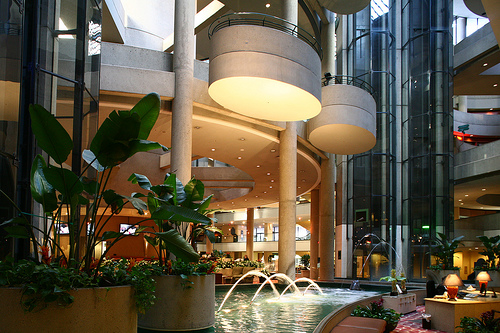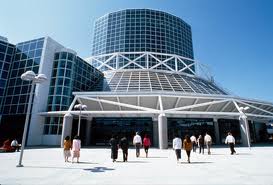I’m standing in the street in downtown LA with two friends who are staying at the Bonaventure Hotel, site of Fredric Jameson’s famous rant about postmodernism. But we can’t see the monument although we know we are within two blocks. As they go, I look up and realize that all around me are vast new towers built by banks. Postmodernism got occupied.
Jameson was in LA for the annual meeting of the Modern Language Association. I’m here for the similar College Art Association, which is the scholarly association for art historians, artists and museum professionals, even though I’m none of these now. Whereas Jameson probably spent his meeting in the Bonaventure, traveling up and down its towers in the exposed lifts (see above) that once seemed so different, I have to traipse down to the LA Convention Center.
This is the kind of space for which the words “soulless,” “cavernous” and “gloomy” were designed, although it is of course brightly lit by cheap neon lights, even as sunshine pours down outside, dispelling the winter smog. Everyone feels obliged to comment on how all ambition and optimism is at once stripped away by being in such a space. And this is, you come to realize, its own form of cultural logic. The big box building, which might just as well be a Walmart or a Target, exists to process cultural purchases in the same way a discount chain exists to move low-cost commodities. “Don’t feel special,” the space says. “You’re just another customer.”
The bank towers that shape the LA skyline express this logic all too clearly. They are generic buildings, stalking over the landscape. They are to 2012 what the Terminator was to the imaginary of postmodernism. These artificial intelligences compete effectively with humans for control of space. Like the Terminator, they seem impossible to defeat and prompt a certain despair in their opponents. Is it even possible to fight global capitalism, people ask?
Down at ground level, far beneath the notice of the Towers, a different cultural dynamics can be observed. On the one hand, downtown has revived. There are cool cafés, often using untouched 1940s spaces. At the same time, there’s still no shortage of homeless people and the visibly impoverished, trying to get by among the new plate glass monoliths. Finally, almost unnoticed in this corner of town, the less glamorous Oscar people are arriving. The older actors and directors that no one now remembers are checking-in to their less glitzy hotels. The Biltmore, where I’m staying, is one such, haunted by the ghosts of Bette Davis and Jimmy Stewart, who once accepted Oscars here. In Phoenix, I met a woman who danced with Fred Astaire in Silk Stockings (1957). She’s now an Occupy supporter.
Downtown LA is visually hard to separate from similar buildings that I saw in Phoenix. People tell you without prompting that thirty years ago, none of those towers existed in Arizona. If Andrew Ross is right in his new book, they shouldn’t now, and certainly ought not to remain in the climate-changed future present. In Phoenix, they clear land by means of two bulldozers passing across a space with a chain attached to each that tears out all the vegetation. What remains is a flat space, perfect for rapid real-estate speculation. From the air at least, what seems more typical of present-day cultural logics is an empty version of such a space, perfectly geometric, brown and flat, awaiting an exploitation that will now not come. Property values are down over 50% in Phoenix.
Glass towers and geometric spaces of desert cleared for climate-destroying McMansions. Such are the dynamics of neo-liberalism’s cultural logics. I’m off to the Bonaventure for a little nostalgic trip down postmodernism’s memory lane, to try to remember how this once seemed like the worst thing imaginable.


